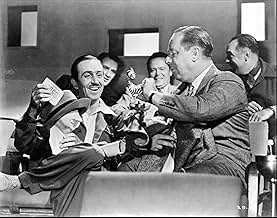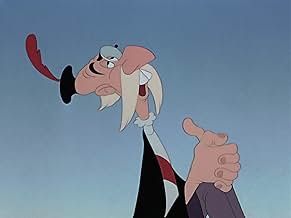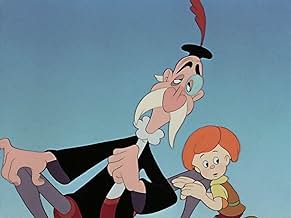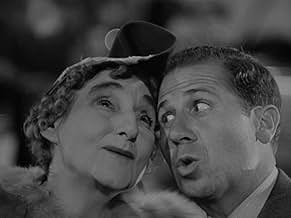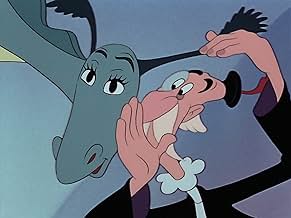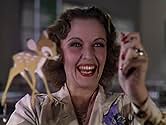VALUTAZIONE IMDb
6,7/10
4103
LA TUA VALUTAZIONE
Aggiungi una trama nella tua linguaHumorist Robert Benchley learns about the animation process at Walt Disney Studios while trying to find the great man himself to pitch him the idea of making a cartoon about a shy dragon.Humorist Robert Benchley learns about the animation process at Walt Disney Studios while trying to find the great man himself to pitch him the idea of making a cartoon about a shy dragon.Humorist Robert Benchley learns about the animation process at Walt Disney Studios while trying to find the great man himself to pitch him the idea of making a cartoon about a shy dragon.
- Premi
- 1 vittoria in totale
Norman Ferguson
- Norm Ferguson
- (as Norm Ferguson)
Jim Luske
- Jimmy - Baby Weems Model
- (as Jimmy Luske)
Hamilton MacFadden
- Hamilton MacFadden
- (as Hamilton Mac Fadden)
Ernie Alexander
- Baby Weems' Father
- (voce)
- (non citato nei titoli originali)
Recensioni in evidenza
Humorist Robert Benchley is at home. His wife convinces him to sell the rights for his story 'The Reluctant Dragon' to Walt Disney. She drags him to the studio and leaves him there. He wanders around the studio and discovers the animation process along the way. Finally he meets Walt Disney himself.
This starts as a black and white live action fictional drama. The fact that it's not animation made it less than successful originally. However it's fascinating to see where Disney began and what it looked like. It's a studio tour dressed up as a little story. This is terrific as a time capsule and a fun way to see how it was made. This is probably a good movie to show new hires at the time. After 25 minutes, the movie turns into technicolor with some animation. Goofy has a cartoon about how to ride a horse. The final section has the Reluctant Dragon cartoon. This movie has a bit of historical values but as a story, this is rather bland.
This starts as a black and white live action fictional drama. The fact that it's not animation made it less than successful originally. However it's fascinating to see where Disney began and what it looked like. It's a studio tour dressed up as a little story. This is terrific as a time capsule and a fun way to see how it was made. This is probably a good movie to show new hires at the time. After 25 minutes, the movie turns into technicolor with some animation. Goofy has a cartoon about how to ride a horse. The final section has the Reluctant Dragon cartoon. This movie has a bit of historical values but as a story, this is rather bland.
God, I love this film. It's just such fun.
At the time this film was made, Disney was primarily known for his animation but was positively itching to branch out into live-action. This is his first venture into "traditional" filmmaking. The story concerns comedic actor Robert Benchley (whose "How To" film series inspired many classic Goofy shorts) who, at the urging of his wife, searches the Disney studio top to bottom trying to sell Walt on the idea of making a movie about Kenneth Grahame's "The Reluctant Dragon" (Grahame's masterpiece "The Wind in the Willows" wouldn't become a Disney film for many years yet.) On the way he meets voice actors, musicians, animators (one played by Alan Ladd) and even Donald Duck and Goofy. When he finally finds Walt, he is shocked to see that his story has already been produced as one of Disney's most charming animated shorts.
Needless to say, this film is pretty dated in the age of "Toy Story" and "Finding Nemo" (I refuse to put the Dreamworks' "S" word in the same category as these two features) but the interesting thing is how many of these tried-and-true practices remain in effect to this day.
Surprisingly, this live-action film is ideal for animation fans. Not so much for the "How does it work?" element, but just the thrill in being immersed in that world. From sound effects recording to paint application. And Benchley's funny, let's not forget that.
At the time this film was made, Disney was primarily known for his animation but was positively itching to branch out into live-action. This is his first venture into "traditional" filmmaking. The story concerns comedic actor Robert Benchley (whose "How To" film series inspired many classic Goofy shorts) who, at the urging of his wife, searches the Disney studio top to bottom trying to sell Walt on the idea of making a movie about Kenneth Grahame's "The Reluctant Dragon" (Grahame's masterpiece "The Wind in the Willows" wouldn't become a Disney film for many years yet.) On the way he meets voice actors, musicians, animators (one played by Alan Ladd) and even Donald Duck and Goofy. When he finally finds Walt, he is shocked to see that his story has already been produced as one of Disney's most charming animated shorts.
Needless to say, this film is pretty dated in the age of "Toy Story" and "Finding Nemo" (I refuse to put the Dreamworks' "S" word in the same category as these two features) but the interesting thing is how many of these tried-and-true practices remain in effect to this day.
Surprisingly, this live-action film is ideal for animation fans. Not so much for the "How does it work?" element, but just the thrill in being immersed in that world. From sound effects recording to paint application. And Benchley's funny, let's not forget that.
After filming the live-action sequences of "Fantasia" and hurting for a "feature release" following the financial fiascos of the aforementioned feature, presumably Disney rushed this into production (with most of it live-action, it not only cost less than a fully-animated counterpart of equal length, it took much less time to complete).
It purports to tell the story of how Disney animated cartoons are made, but, courtesy of a disclaimer at the beginning of the movie, it turns out to be more fiction than fact.
Various processes - like sound recording, paint-mixing, cell-photographing, multi-planing, etc - are all upended for the sake of humor (in one instance, a complete cel of Donald Duck comes to life, in another instance, the sound effects crew creates an "unplanned" cacophony by knocking over all the equipment).
More to the point is that the sequences are not just staged, but they employ professional actors (such as Alan Ladd!) portraying Disney animators and other staff (although in certain instances, actual animators such as Woolie Reitherman and Ward Kimball make appearances).
The "Baby Weems" sequence is often commended by many for being innovative and the forerunner of the UPA-style that would dominant the art of animation in the 1950s, but the fact is that "Weems" is nothing more than a sleek, streamlined version of a "leica reel" (a film which combines the pre-recorded soundtrack with the animators' storyboard sketches, as a way of assessing how story pacing and timing are before *before* any time and effort are spent creating fully-animated sequences). The story is cute, the drawings are more fully- rendered than they would be in a genuine Leica reel so they are nice to see, but "innovative"? I don't think so.
The Goofy "How-to" sequence is okay (I never cared for the "How-To" series, but I know a similarly-themed version in "Saludos Amigos" with Goofy trying to be a Gaucho is funnier).
The title short - "The Reluctant Dragon" - is cute and funny. I don't think it rates as a classic, but because it is such a rarely-viewed piece it needs to be watched by all Disney-philes.
Considering its historic value, this movie is hardly a waste of time. It's just not one that deserves repeated viewings.
It purports to tell the story of how Disney animated cartoons are made, but, courtesy of a disclaimer at the beginning of the movie, it turns out to be more fiction than fact.
Various processes - like sound recording, paint-mixing, cell-photographing, multi-planing, etc - are all upended for the sake of humor (in one instance, a complete cel of Donald Duck comes to life, in another instance, the sound effects crew creates an "unplanned" cacophony by knocking over all the equipment).
More to the point is that the sequences are not just staged, but they employ professional actors (such as Alan Ladd!) portraying Disney animators and other staff (although in certain instances, actual animators such as Woolie Reitherman and Ward Kimball make appearances).
The "Baby Weems" sequence is often commended by many for being innovative and the forerunner of the UPA-style that would dominant the art of animation in the 1950s, but the fact is that "Weems" is nothing more than a sleek, streamlined version of a "leica reel" (a film which combines the pre-recorded soundtrack with the animators' storyboard sketches, as a way of assessing how story pacing and timing are before *before* any time and effort are spent creating fully-animated sequences). The story is cute, the drawings are more fully- rendered than they would be in a genuine Leica reel so they are nice to see, but "innovative"? I don't think so.
The Goofy "How-to" sequence is okay (I never cared for the "How-To" series, but I know a similarly-themed version in "Saludos Amigos" with Goofy trying to be a Gaucho is funnier).
The title short - "The Reluctant Dragon" - is cute and funny. I don't think it rates as a classic, but because it is such a rarely-viewed piece it needs to be watched by all Disney-philes.
Considering its historic value, this movie is hardly a waste of time. It's just not one that deserves repeated viewings.
"The Reluctant Dragon" got a somewhat hostile response from critics when it first came out. To some degree, I can understand the negative reaction. For one thing, it often comes more like an advertisement for the Disney company instead of an original story. Also, while the movie promises to answer some questions to its audience about how cartoons are made, it doesn't go into that much depth about the subject. And some of what it presents is wrong, from hiring actors to play cartoon staff to suggesting that the audio for a cartoon is made after the animation is done. It also doesn't help that while Robert Benchley was a funny guy elsewhere, the material given to him as the movie's pseudo-host just isn't that funny.
But if you are an animation buff and/or a Disney buff, the movie does have its rewards. There are occasional legitimate peeks into the Disney company at the time, and those peeks do have some interest. And while the live action footage is mostly disappointing, the animated sequences do deliver - not just the title cartoon, but also "Baby Weems" and the Goofy cartoon. I don't know if kids would sit still for the entire movie, but those certain adults I mentioned at the start of this paragraph should find the movie has its rewards.
But if you are an animation buff and/or a Disney buff, the movie does have its rewards. There are occasional legitimate peeks into the Disney company at the time, and those peeks do have some interest. And while the live action footage is mostly disappointing, the animated sequences do deliver - not just the title cartoon, but also "Baby Weems" and the Goofy cartoon. I don't know if kids would sit still for the entire movie, but those certain adults I mentioned at the start of this paragraph should find the movie has its rewards.
This little classic spends just short of an hour touring the Disney Studios in the company of Robert Benchley, the humorist who acts like a big kid in a candy store (and is thus the perfect guide for something like this).
We see how the cartoons are made, moving from the recording studio - where the real-life voices of Donald Duck and Clara Cluck sing an aria - through to clay models of the characters to be animated - the sound effects dept. (we see the full Casey Junior sequence, some of which ended up in 1941's 'Dumbo') - the scenario department (we see a whole cartoon - Baby Weems - in storyboard format) - the animation department (we see a cartoon feature on riding a horse, and see Donald Duck showing us how he walks) - and much more. There's also a neat segue from black and white to Technicolor.
'The Reluctant Dragon' is a book which Benchley hopes to pitch to Disney, only to find the film has already been made; the last 20 minutes of this feature is the cartoon about the (rather camp) dragon, and a classic bit of Disney work.
The whole movie is engrossing and a fantastic overview of the state-of-the-art work being done by the Disney Studios at the beginning of the 40s.
We see how the cartoons are made, moving from the recording studio - where the real-life voices of Donald Duck and Clara Cluck sing an aria - through to clay models of the characters to be animated - the sound effects dept. (we see the full Casey Junior sequence, some of which ended up in 1941's 'Dumbo') - the scenario department (we see a whole cartoon - Baby Weems - in storyboard format) - the animation department (we see a cartoon feature on riding a horse, and see Donald Duck showing us how he walks) - and much more. There's also a neat segue from black and white to Technicolor.
'The Reluctant Dragon' is a book which Benchley hopes to pitch to Disney, only to find the film has already been made; the last 20 minutes of this feature is the cartoon about the (rather camp) dragon, and a classic bit of Disney work.
The whole movie is engrossing and a fantastic overview of the state-of-the-art work being done by the Disney Studios at the beginning of the 40s.
Lo sapevi?
- QuizThe Mickey Avenue/Dopey Drive signpost was built specifically for the movie, and was supposed to be removed afterward. It wasn't, and it still stands at the Disney studio.
- Curiosità sui creditiThe animation credits include caricatures and signatures of the crew.
- Versioni alternativeTypically releases of this film have the sequences How to Ride A Horse and the title featurette as separate films with the live action footage excised.
- ConnessioniFeatured in L'ami public numéro un: L'usine à rêves (1962)
I più visti
Accedi per valutare e creare un elenco di titoli salvati per ottenere consigli personalizzati
- How long is The Reluctant Dragon?Powered by Alexa
Dettagli
- Data di uscita
- Paese di origine
- Sito ufficiale
- Lingua
- Celebre anche come
- Il Drago Recalcitrante
- Luoghi delle riprese
- Azienda produttrice
- Vedi altri crediti dell’azienda su IMDbPro
Botteghino
- Lordo Stati Uniti e Canada
- 872.000 USD
- Tempo di esecuzione
- 1h 14min(74 min)
- Proporzioni
- 1.37 : 1
Contribuisci a questa pagina
Suggerisci una modifica o aggiungi i contenuti mancanti





